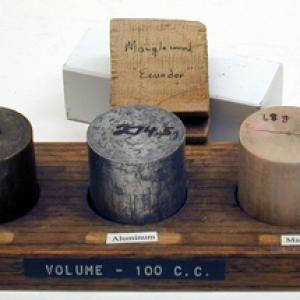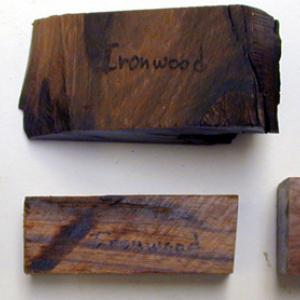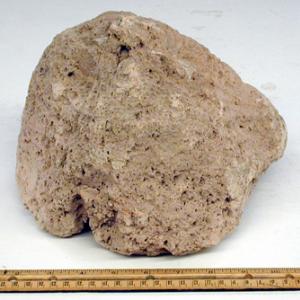College of Liberal Arts & Sciences
2B40.61 - Density Blocks
All of these blocks have the same volume. We have blocks of lead, brass, aluminum, maple, and balsa. Floating these in a tank of water will give you a visual comparison of the densities.
The mangle wood, the iron wood and the lignum vitae are some of the few woods that are dense enough to sink in water.
The pumice rocks have a density which allows them to float in water much like an iceberg.
The two silver balls both have the same mass, but the densities are vastly different. One has a diameter of 2.86 cm and will sink in water, and the other has a diameter of 12.7 cm and will float very nicely.
- Sanjoy Kumar Pal, Soumen Sarkar, Pradipta Panchadhyayee, "Use of a Smartphone as a Density-Measuring Device", TPT, Vol. 62, #9, Dec. 2024, p. 786.
- Joseph Priest and David F. Griffing. "Model for an Undergraduate Physics Problem", TPT, Vol. 28, # 4, p. 210, April 1990.
- R. Delbourgo, "The Floating Plank", AJP, Vol. 55, # 9, September 1987.
- B.Camerin Reed, "Archimedes' Law Sets A Good Energy-Minimization Example", Physics Education, Vol. 39, # 4, July 2004, p. 322.
- Julius Sumner Miller, Q175 & A175, Millergrams II – Some More Enchanting Questions for Enquiring Minds, p. 43 & 99.
Disclaimer: These demonstrations are provided only for illustrative use by persons affiliated with The University of Iowa and only under the direction of a trained instructor or physicist. The University of Iowa is not responsible for demonstrations performed by those using their own equipment or who choose to use this reference material for their own purpose. The demonstrations included here are within the public domain and can be found in materials contained in libraries, bookstores, and through electronic sources. Performing all or any portion of any of these demonstrations, with or without revisions not depicted here entails inherent risks. These risks include, without limitation, bodily injury (and possibly death), including risks to health that may be temporary or permanent and that may exacerbate a pre-existing medical condition; and property loss or damage. Anyone performing any part of these demonstrations, even with revisions, knowingly and voluntarily assumes all risks associated with them.



